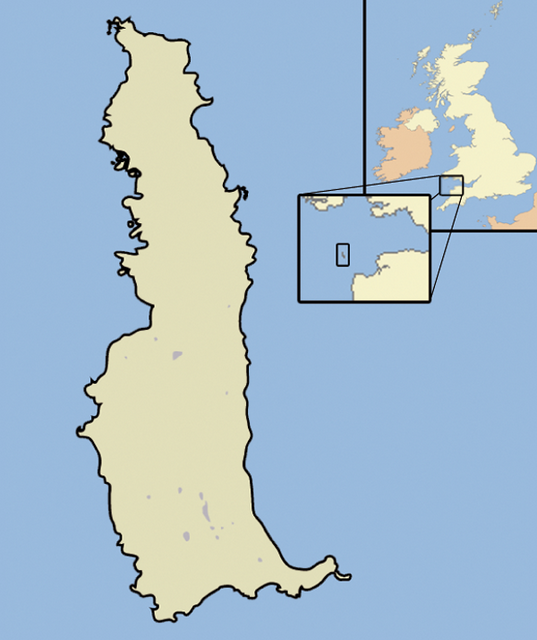 Lundy is an island 3 miles (4.8 km) long and ½ mile (0.8 km) wide off the north coast of Devon in the south west of the United Kingdom, where the Bristol Channel meets the Atlantic Ocean.
Lundy is an island 3 miles (4.8 km) long and ½ mile (0.8 km) wide off the north coast of Devon in the south west of the United Kingdom, where the Bristol Channel meets the Atlantic Ocean.
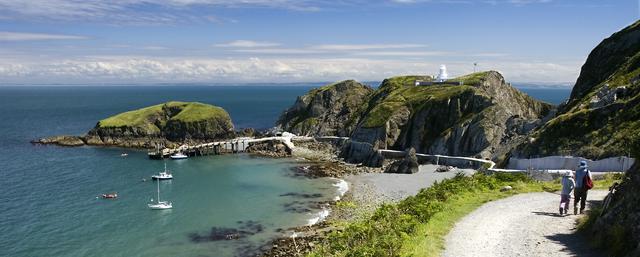 The island is owned by the National Trust and run by the Landmark Trust, a UK charity organisation. All profit from visitors is reinvested into the upkeep of the island.
The island is owned by the National Trust and run by the Landmark Trust, a UK charity organisation. All profit from visitors is reinvested into the upkeep of the island.
The island is a large granite formation with very high cliffs. There is an abundance of wildlife on the land and in the surrounding sea. Many rare birds visit or live on the island including Puffins, after which the island is named. There is lots to see even for non-bird watchers, including amazing scenery and many historic buildings. The island only has 20 residents, all employees of the Landmark trust, but has a castle, a church, three lighthouses (two operational, one decommissioned), a farm, a tavern, a small shop and many other buildings.
The island is steeped in history and has some very interesting places to visit regardless of your archaeological interests. One of the best things about Lundy is that it is totally un-commercial and there are no signs and the only fences or barriers are there to keep the farm animals in. The only sign of a 'tourism market' is the village shop selling puffin toys.
- Old Light. Old Light is reputed to be the highest lighthouse in England and was decommissioned as it spends much of its time in bad weather with its head in the clouds. The lighthouse is still open to visit and you can climb the very steep and precarious spiral staircase to the very top where the light platform now accommodates two deck chairs, from which the whole island can be observed.
- South Lighthouse. A grade-II listed lighthouse which was first built in 1897.
- North Lighthouse. The island's second 'modern' grade-II listed lighthouse, which together with the South Lighthouse have replaced the Old Light.
- Marisco Castle. Built by King Henry III in the 13th century to establish sovereignty and the rule of law over the island. It is named after the Marisco family, who had earlier in the century tried to have Henry III killed.
- St Helena's Church. The current church building is from the late-19th century - but is on a site where there has been a graveyard and chapel since at least the 9th century.
- Pondsbury. The largest pool on the island, which was built to store water for the summer. Local flora and fauna can still be seen surrounding the pond, and carp can still be found in it.
- Remains of a German Heinkel 111H bomber. In 1941, during World War II, two German Heinkel bomber planes crashed on the island. Although most of the wreckage has been since salvaged or plundered, some remnants of the planes can still be seen here. The other plane's crash site is on the cliffs, to the west of Pondsbury.
- Quarry Cottages. Now ruined cottages that were built in the 1860s to house some of the staff who worked for the company operating the nearby quarry.
- Lundy quarry. The island was quarried for granite during the mid-19th century, and the remains of these quarries can still be seen today on the eastern edge of the island.
- The Earthquake. A large chasm on the western side of the island, which some claim was caused by the shockwaves of an earthquake in Lisbon, Portugal in 1755. However, modern geologists doubt this was the actual cause of this feature.
Old Light. Old Light is reputed to be the highest lighthouse in England and was decommissioned as it spends much of its time in bad weather with its head in the clouds. The lighthouse is still open to visit and you can climb the very steep and precarious spiral staircase to the very top where the light platform now accommodates two deck chairs, from which the whole island can be observed.
South Lighthouse. A grade-II listed lighthouse which was first built in 1897.
North Lighthouse. The island's second 'modern' grade-II listed lighthouse, which together with the South Lighthouse have replaced the Old Light.
Marisco Castle. Built by King Henry III in the 13th century to establish sovereignty and the rule of law over the island. It is named after the Marisco family, who had earlier in the century tried to have Henry III killed.
St Helena's Church. The current church building is from the late-19th century - but is on a site where there has been a graveyard and chapel since at least the 9th century.
Pondsbury. The largest pool on the island, which was built to store water for the summer. Local flora and fauna can still be seen surrounding the pond, and carp can still be found in it.
Remains of a German Heinkel 111H bomber. In 1941, during [[World War II in Europe|World War II]], two German Heinkel bomber planes crashed on the island. Although most of the wreckage has been since salvaged or plundered, some remnants of the planes can still be seen here. The other plane's crash site is on the cliffs, to the west of Pondsbury.
Quarry Cottages. Now ruined cottages that were built in the 1860s to house some of the staff who worked for the company operating the nearby quarry.
Lundy quarry. The island was quarried for granite during the mid-19th century, and the remains of these quarries can still be seen today on the eastern edge of the island.
The Earthquake. A large chasm on the western side of the island, which some claim was caused by the shockwaves of an earthquake in [[Lisbon]], [[Portugal]] in 1755. However, modern geologists doubt this was the actual cause of this feature.
Being an island without roads or other 'modern' amenities - exploring the island on foot is one of the main attractions to Lundy. The island is host to many different species of animals and plants - including puffins, seals, and goats. Lundy also has its own breed of horse, the Lundy pony - bred from a mix of other UK breeds, and now known as a tough horse due to the island's terrain.
A walk around the whole island would likely take a few hours at least - especially if time is taken to properly explore all the sites on the island. On your walk, remember to take things such as water, sun cream (if sunny), and proper footwear.
It is also possible to kayak to (and around) Lundy. Experienced kayakers with their own kayak should find this an enjoyable challenge - starting from either the coast along Ilfracombe or Lee Bay; or from Hartland Point. For those who are less experienced, contact a kayaking company - such as Sea Kayak Devon - for advice and to see if they can offer any help.
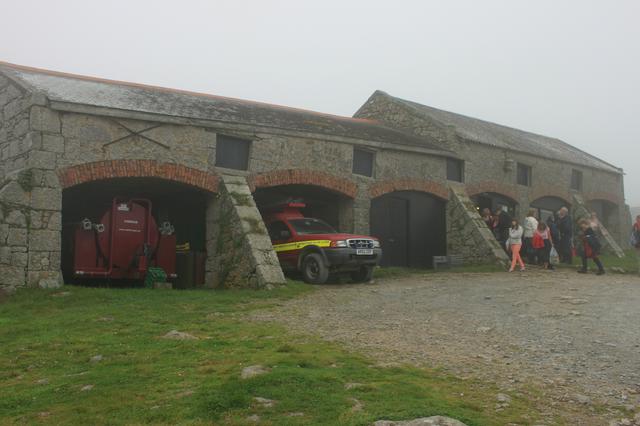
- Lundy General Stores, +44 1237 431831. This is the one shop on the island. It sells food, camping supplies, and souvenirs. If staying on Lundy, you can order what you'd like to have during your stay to your accommodation, but make sure to do this at least 14 days before your arrival.
Lundy General Stores, +44 1237 431831. This is the one shop on the island. It sells food, camping supplies, and souvenirs. If staying on Lundy, you can order what you'd like to have during your stay to your accommodation, but make sure to do this at least 14 days before your arrival.
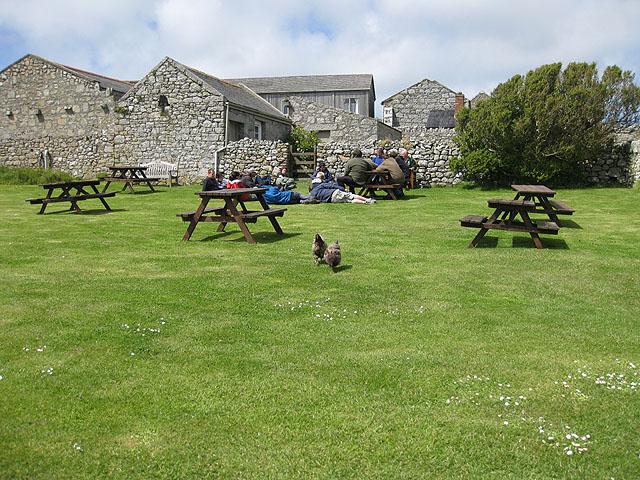 Full cooking facilities and utensils are available if you want to cook in the accommodation, but the island also has a popular pub serving alcohol and food.
Full cooking facilities and utensils are available if you want to cook in the accommodation, but the island also has a popular pub serving alcohol and food.
- Marisco Tavern, +44 1237 431831. The food at the Marisco Tavern is good quality and plentiful, and uses much of the island's own produce. The main meals are kept on a warm burner, so you will not have to wait for your meal unless you order something different - the cooks are very flexible. A main meal costs about the same as a normal UK pub meal, but the quantities are far larger and the quality of cooking exceeds that of many very expensive restaurants. Breakfast, lunch and tea are available, and the desserts are amazing.
Marisco Tavern, +44 1237 431831. The food at the Marisco Tavern is good quality and plentiful, and uses much of the island's own produce. The main meals are kept on a warm burner, so you will not have to wait for your meal unless you order something different - the cooks are very flexible. A main meal costs about the same as a normal UK pub meal, but the quantities are far larger and the quality of cooking exceeds that of many very expensive restaurants. Breakfast, lunch and tea are available, and the desserts are amazing.
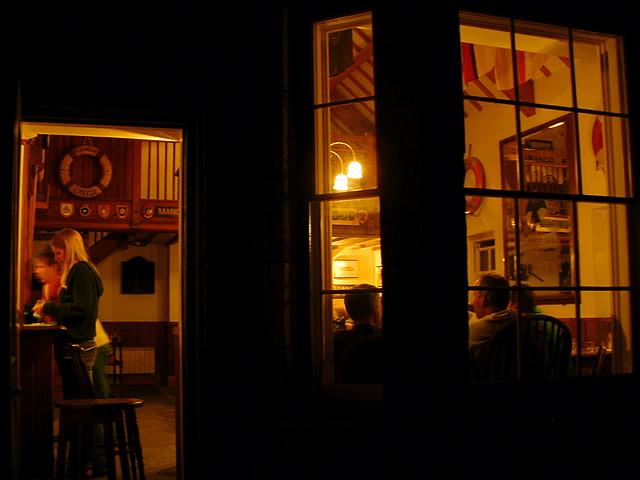 The Marisco Tavern, although operating as the island's only restaurant, is also a 'traditional' pub, where beers, liquors, and wines are served. The pub also encourages musicians to play if on the island, so occasionally live music can be heard there too.
The Marisco Tavern, although operating as the island's only restaurant, is also a 'traditional' pub, where beers, liquors, and wines are served. The pub also encourages musicians to play if on the island, so occasionally live music can be heard there too.
Alternatively, alcohol could be brought to Lundy in your luggage - but be careful, as alcohol and cliffs, such as those found on the island, generally don't mix too well.
Like Foulness Island, Lundy Island is an extremely safe place to live and visit, with basically no crime at all on the island. Being on the edge of the Atlantic ocean with little shelter, Lundy's weather can be extreme during the winter months. Storms can include Force 10-11 winds (up to 70 mph or 115 km/h) winds. During the summer months, Lundy can often be much warmer than the mainland. Bring good walking shoes, waterproof clothing, and most importantly, your sense of adventure!
Lundy generates its own electricity and collects its own water. There are no televisions, radios or telephones in the accommodation. It is the perfect antidote for a hectic work life. The island is a perfect place to wind down and relax and it is very easy to forget about life on the mainland. It doesn't matter whether you choose to explore every hidden corner of the island or stay in your warm cottage and enjoy the view and the serenity.
Go back to Bideford or Ilfracombe via the MS Oldenburg. If you got here with your own boat, you could sail north towards South Wales, for places such as Pembrokeshire Coast National Park or Swansea. If your boat is big enough, Ireland could be another destination - such as Waterford or Cork.
